 MY
Train TraVelS In Europe - 1995 and 2009
MY
Train TraVelS In Europe - 1995 and 2009
First Class Electrics and Ancient Steamers
This photo essay covers an escorted tour I took in 1995
through Germany, Austria, and Switzerland in 5 followed by a
reprise of Switzerland in 2009. Both tours covered quite
different routes and scenery.
 Germany
- 1995
Germany
- 1995
My photos were lost in a house fire
but about 50% of the negatives survived. My brother Ian scanned
and cropped the useable film and here they are. The mix is about
equal parts real trains, large scale model trains, and scenic
images. I hope you enjoy the trip.
 The
route started with Calgary to Frankfurt by Lufthansa/Air Canada,
then by train to Nurnberg where I joined the tour group from the
USA. After a sumptuous meal and an overnight in an ancient hotel,
we toured the LGB model train factory. There is a very impressive
display railway built by Malcolm Furlow. The factory is huge and
full of fascinating machinery.
The
route started with Calgary to Frankfurt by Lufthansa/Air Canada,
then by train to Nurnberg where I joined the tour group from the
USA. After a sumptuous meal and an overnight in an ancient hotel,
we toured the LGB model train factory. There is a very impressive
display railway built by Malcolm Furlow. The factory is huge and
full of fascinating machinery.
Unlike
North America, train watching at the passenger station is a busy
pastime most of the day. At Nurnberg and Munich, we watched various
classes of passenger trains glide in and out almost silently under
their electric overhead wires. These are standard gauge (1435
mm) trains.
 Train
Watching in Nurnberg
Train
Watching in Nurnberg
|

DB
Local Passenger Train
|

ICE
Intercity Express |
|

More
DB Locals
|
|

DB
Express Passenger Train
|
|
|
|
 LGB
Factory and Display Railways LGB
Factory and Display Railways |

Malcolm
Furlow's LGB Display Railway at Nurnberg
|
|

More
Displays at the LGB Factory |
|
|
|
 Ships
and Castles at Regensberg Ships
and Castles at Regensberg
Next
stop was Regensberg by our tour bus to visit the castle and Josef
Schmaltz's world renowned garden railway (45 mm gauge representing
meter gauge at a scale of 1:22.5). Regensberg is halfway between
Nurnberg and Munich (Munchen).
|
|
|

Regensberg
Scenes
|
|
|
 Josef
Schmaltz and his Large Scale Garden Railway Josef
Schmaltz and his Large Scale Garden Railway
Richard Schafer, our tour leader, passed away in September
2002 and is sadly missed by the readers of Garden Railways
Magazine. You can see more about the Schmaltz railway in the
April 1999 issue of Garden Railways. Richard Schafer's
Galena Railway and Navigation Company was pictured in the
July/August 1992 issue. |
|
|
|
|
|
The
Schmaltz Garden Railway and some of our tour group. |
|
| |
|
 The Munich Transportation Museum The Munich Transportation Museum
 We
stayed in Munich a couple of days to see the old city, take part
in pre-Octoberfest, and visit the Munich Science Museum. Many
fabulous antiques, from trains to automobiles to airplanes to
ships, are on display, along with many large scale working models.
There is much more to see: art galleries, the old walled city
(now shops, boutiques, and restaurants), ancient and modern streetcars
on the U-Bahn, and the modern trains on the S-Bahn. We
stayed in Munich a couple of days to see the old city, take part
in pre-Octoberfest, and visit the Munich Science Museum. Many
fabulous antiques, from trains to automobiles to airplanes to
ships, are on display, along with many large scale working models.
There is much more to see: art galleries, the old walled city
(now shops, boutiques, and restaurants), ancient and modern streetcars
on the U-Bahn, and the modern trains on the S-Bahn.
We
took a day trip by train to Augsberg and returned to Munich. Outbound
was a classy second class through train with a super ride and
lots of interior comfort. The return was on a third class local
that made every stop. The ride was surprisingly rough when you
consider it uses the same track as the 1st and 2nd class trains.
|
|

An
elaborate automatic model train is a "must-see"
display at Munich Science Museum |
|
|

These
photos are from the Munich Science Museum website, as mine
were lost in the fire.
|
|
|
|
 Chiemsee
and King Ludwig's Palace Chiemsee
and King Ludwig's Palace
Our
last stop in Germany was near the German-Austrian border at Chiemsee
to visit the antique railway (meter gauge) and the Palace of King
Ludwig II on Chiemsee Island. He had the palace built to mimic
Versailles and it is very well preserved. King Ludwig was also
known as Mad Ludwig. He may have been crazy but he built a beautiful
country "home"! Later that day, we moved on to Salzberg
in Austria.
|

Across
the Lake to the Island
|
|

Approaching
the Palace
|
|

Inside
the Palace
|
|

Fountains
and View from the Palace Steps
|
|
|
|
 Chiemsee
Bahn Chiemsee
Bahn |
|
|
My
photos of the Chiemseebahn were lost. These are close
to what I had, swiped from various web pages.
The
original steamer was built in 1813 and is still running.
A diesel with similar shape to the original is used for
a spare. We rode behind the steamer.
|
|
 |
 Austria
- 1995
Austria
- 1995
 The
Austrian segment of the trip took us to Saltzburg, St Wolfgang,
Berchtesgaden, Jenbach, Achensee, Innsbruck, and Feldkirk where
we entered Switzerland through Liechtenstein, one of the smallest
countries in the world.
The
Austrian segment of the trip took us to Saltzburg, St Wolfgang,
Berchtesgaden, Jenbach, Achensee, Innsbruck, and Feldkirk where
we entered Switzerland through Liechtenstein, one of the smallest
countries in the world.
 The mainline through
trains in Austria are standard gauge run by OBB. There are large
meter gauge installations like the Zillertahlbann and many small
restored tourist lines.
Click
here to see a map of Austria's rail network.
The mainline through
trains in Austria are standard gauge run by OBB. There are large
meter gauge installations like the Zillertahlbann and many small
restored tourist lines.
Click
here to see a map of Austria's rail network.
In Salzburg, we toured the fortress and the ancient town streets.
Salzburg is the home of Mozart and the inspiration for "The
Sound of Music", in which the Von Trapp family's trials and
tribulations are sung. Much is made of both these tourist attractions,
but there are many other sights.
 Salzburg
Scenes Salzburg
Scenes |
|
|
|
 My
photos of Salzburg were lost in the fire. These come from
the Salzburg official website.
My
photos of Salzburg were lost in the fire. These come from
the Salzburg official website. |
 St
Wolfgang and Schafberg bahn St
Wolfgang and Schafberg bahn
Next
day, we headed a short distance to St Wolfgang, on Wolfgangsee,
via ferry, to visit the Schafbergbahn, a really steep narrow gauge
rack railway still using steam engines. This is a beautiful spot
with tiny streets and tiny hotels - the largest has 12 rooms.
The Weisse Rossl (White Horse) is best known and most visible.
Tourism is the only industry here.
|
|
|
 Schafbergspitz
and St Wolfgang Scenes
Schafbergspitz
and St Wolfgang Scenes |
|
|
|
 "Prunel"
and "Anemone" Rack Locos on Display
"Prunel"
and "Anemone" Rack Locos on Display
|
|
| |
|
 Berchtesgaden
and Konigsee Berchtesgaden
and Konigsee
From
Salzburg, our bus took us to Berchtesgaden and Konigsee, the vacation
retreat of Adolph Hitler more than 60 years ago. It is now a National
Park and a major tourist destination for its scenic beauty and
unspoiled natural setting (there are no trains, darn it). We were
serenaded at lakeside by an Austrian band playing Hawaiian music!
|
|
|

Views
from the Eagles Nest |
|
|
|
  Jenbach
and Zillertal bahN Jenbach
and Zillertal bahN
Our
bus got us to Innsbruck in time for a late supper and bed. In
the morning we backtracked to Jenbach to watch the Zillertalbahn
operations and ride the train part way up the valley. The entire
Ziller valley is a great train watching venue, The famous Bier
Keg tavern car of the Zillertalbahn was in the shed at Jenbach,
but we didn't get to ride in it
|
|
|
 Zillertalbahn
Trains at Jenbach
Zillertalbahn
Trains at Jenbach |
|
|
|
 More
Variety at Jenbach
More
Variety at Jenbach |
|
|
|
 Achensee
and Achensee BAHN Achensee
and Achensee BAHN
 Next
day, we returned to Jenbach to board the Achenseebahn, another
narrow gauge rack railway with steam locomotives. The Achenseebahn
terminates at the lake, where a steam paddle-wheel ferry can be
taken to the other shore. This is a big lake with imposing mountain
peaks and glaciers. The town is small, very neat, and offers a
decent lunch. Next
day, we returned to Jenbach to board the Achenseebahn, another
narrow gauge rack railway with steam locomotives. The Achenseebahn
terminates at the lake, where a steam paddle-wheel ferry can be
taken to the other shore. This is a big lake with imposing mountain
peaks and glaciers. The town is small, very neat, and offers a
decent lunch.
On
return to Innsbruck, we spent another night and toured the town
a bit. The Winter Olympics were held here in 1964 and they are
still very proud of the fact, The OBB mainline and the yards at
Innsbruck are also great train watching sites. As well, there
seems to be more operating cable cars per square mile here than
anywhere else in the world.
|

This
picture is from the web - there's no time to set up for
this photo or you miss the boat! All transportation connections
are timed to the minute with Germanic precision.
|
|
|

En
Route to Achensee
|
|
 Innsbruck
Scenes Innsbruck
Scenes |
|
|
|
 It was either too dark or too rainy to take pictures in
Innsbruck, so I grabbed these to give you an idea of what
we missed. It was either too dark or too rainy to take pictures in
Innsbruck, so I grabbed these to give you an idea of what
we missed.
|
 Switzerland
-1995
Switzerland
-1995
 Here,
we rode
on a lot of trains and saw a lot of scenery. The Swiss National
Railway (SBB) is standard gauge (1435 mm).
Click here to see a
map of the Swiss rail network.
Here,
we rode
on a lot of trains and saw a lot of scenery. The Swiss National
Railway (SBB) is standard gauge (1435 mm).
Click here to see a
map of the Swiss rail network.
First
stop was in St Galen to ride the Appenzellbahn and visit the St
Galen LGB Club large scale outdoor railway.
Many trains in Switzerland
operate almost like interurban streetcars. The Appenzellbahn is
one of them. It heads into pastoral farmland on a narrow right
of way, sometimes encroaching onto the equally narrow automobile
roads.
Swiss
train, bus, ferry, and even airplane schedules are highly integrated.
The bus is timed to meet the ferry which is timed to meet the
train - often with only a minute or so to spare. This clockwork
efficiency over-rides corporate and state boundaries, something
we could use a lot more of in North America.

Landwasser
Viaduct
|

Narrow Gauge Steam
|

Paddle
Wheeler
|
As
a souvenir of my trip, I purchased 3 Swiss railway prints and
framed them for my living room. You can see more of
Gerald
Savine's
paintings HERE. |
 St
Galen LGB Club Layout St
Galen LGB Club Layout
The
St Galen LGB Club layout is a work of art and it's hard to tell
how many trains are running; there are quite a few. It rained
just a bit, so some trains would spin a bit on the grades, but
all performed extremely well. There are more than 1000 meters
(3300 feet) of track, all of it with automatic block signals and
station stops.
|
|
|
|
|
|
I
took a full roll of film here. These are the best. |
 Train
Watching at Chur Train
Watching at Chur
 Next
stop was Chur, the headquarters for the Ratischebahn (RhB), and
our tour group for a few days. The city is the most ancient in
Switzerland, dating back at least 5000 years. Some of the cathedrals
are more than 500 years old. The library has documents written
by Irish scholar-monks dating back more than 1000 years! Next
stop was Chur, the headquarters for the Ratischebahn (RhB), and
our tour group for a few days. The city is the most ancient in
Switzerland, dating back at least 5000 years. Some of the cathedrals
are more than 500 years old. The library has documents written
by Irish scholar-monks dating back more than 1000 years!
Chur
to Arosa and return is a day trip with lots of time to wander
around town, shop, and view the lake. The trains are short groups
of modern self-propelled cars running on a narrow, sometimes steep,
right of way. Most passengers are tourists but the local citizenry
are also regular travelers.
|
|
|
|
|
|
Variety
is the spice of train watching. |
|
|
|
 The
Bernina Express The
Bernina Express
Chur
to Tirano (in Italy) and return on the Bernina Express is a long
day trip. Leaving about 6 AM and arriving in Italy in time for
a short lunch (I chose spaghetti carbonara). The return leaves
at 1 PM for a 7:30 PM arrival in Chur. The scenery is breathtaking
and, frankly, more interesting than on the Glacier Express. The
circular viaduct at Brusio is an amazing structure. The Italian
language and architecture, once the train passes the summit of
the Alps, is a real surprise for the uninitiated.

This map shows the entire RhB portion of the Glacier Express as
well as better detail on the spiral tunnels and loops on the Bernina
Express between Filisur and Preda.
|
|
|
|

My
Bernina photos were lost, so here are some good ones from
the web.
|
|
|
 The
Glacier Express The
Glacier Express
The
Glacier Express is actually a number of trains on a number of
routes. One route is from St Moritz to Disentes via the RhB, which
meets another Express from Chur. When merged, they head to Andermatt
on the Furka-Oberalpbahn, then to Brig and Zermatt on the Brig-Viss-Zermattbahn.
The latter two railways use rack locomotives and every second
car on the train must have rack braking systems. Locomotives change
at each change in railway ownership, and passenger cars are added
or deleted as necessary. Through coaches stay connected so you
hardly know anything is happening.

 We
rode the Chur to Zermatt route in a first class observation car.
The "box-lunch" comes in a box all right, but contains
enough food and wine for several days. Scenery along the Rhine
is interesting and cannot be seen by car or bus. Once onto the
rack lines of the Alps, the scenery is a combination of spectacular
to barren. The Bernina route is prettier. We
rode the Chur to Zermatt route in a first class observation car.
The "box-lunch" comes in a box all right, but contains
enough food and wine for several days. Scenery along the Rhine
is interesting and cannot be seen by car or bus. Once onto the
rack lines of the Alps, the scenery is a combination of spectacular
to barren. The Bernina route is prettier.
Zermatt
and the Matterhorn are beyond words - visualize your fondest dreams
of the classic Swiss chalet backed by the most sinister mountain
peak. A lot of people have died on the Matterhorn; the cemetery
is beside the main street. The only internal combustion engine
in Zermatt belongs to the garbage truck. All other vehicles are
electric and scarily quiet.
We
rode the Gornergratbahn closer to the Matterhorn, but it snowed
so we didn't see much of the mountain. This is a steep rack line
with one-way traffic.
No
buses reach Zermatt. You have to take the train back at least
one stop to the bus parking lot, where we departed for Lucerne
on our faithful German tour bus. In Lucerne, we visited the Swiss
Transportation Museum, cruised Lake Lucerne on the old steam powered
ship, and rode the Rigibahn from Vitznau to Goldau.
|
|
|
|
 Train
watching from the Panoramic Observation
Car.
Train
watching from the Panoramic Observation
Car.
|
|
|
|
|
|
|
|
Hotels,
Matterhorn, Cemetery, and electric cars. |
|
|
|
 Lucerne
and the Lake Lucerne
and the Lake |
|
|
|
|
 Misty
day around Lake Lucerne.
Misty
day around Lake Lucerne. |
|
|
|
 Rigi bahn
and Goldau Rigi bahn
and Goldau |
|
|
|
|
|
|
Travel
down Lake Lucerne by steamship, take a slow trip up the
Rigi by rack and rail, and return by a local train from
Goldau - a classic day trip in the heart of Switzerland.
|
|
|
 Swiss
Transportation Museum - LUCERNE Swiss
Transportation Museum - LUCERNE |
|
|
|
|
|
|
I
could have spent a week at the Museum - thousands of preserved
full size and working models.
|
|
|
 Schaffhausen
and the Rhine Schaffhausen
and the Rhine
After
a farewell dinner with the tour group, we were bused to Zurich
where the group boarded for home. I then spent a week in Schafhausen
with friends, viewed the Rhine Falls, floated down the Rhine for
a sumptuous lunch, toured the towns, countryside, monasteries,
and coffee shops. Finally, I trained it back to Frankfurt via
SBB and a DR ICE with only one train change at Munich. |
|
|
|
|
|
|
|
Schaffhausen
and Rhine River scenes were a fitting finale to a fabulous
trip. Special thanks to Lise and Rene, my gracious hosts
for the week. |
 SWITZERLAND REPRISE -- 2009
SWITZERLAND REPRISE -- 2009
Zurich - Interlaken - Montreux - Lake
Geneva
 In
the 14 years between my first trip to Switzerland and this one,
in 2009, some changes were noticeable. The trains are more
modern and more numerous, English speakers are more common, and
tourism is a bigger business. The country is still clean, safe,
and positively beautiful. The trains still meet the planes, the
buses meet the trains, and the ferry boats meet the buses - on
time and for a fair price. The rest of the world should take
note.
In
the 14 years between my first trip to Switzerland and this one,
in 2009, some changes were noticeable. The trains are more
modern and more numerous, English speakers are more common, and
tourism is a bigger business. The country is still clean, safe,
and positively beautiful. The trains still meet the planes, the
buses meet the trains, and the ferry boats meet the buses - on
time and for a fair price. The rest of the world should take
note.
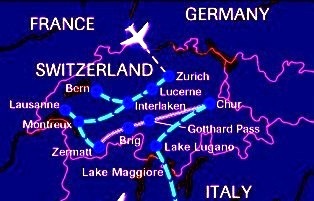 This
trip was run by LGB Tours and guided by the
owners, John Rogers and his family. Centered around Interlaken, jt covered a lot of new ground for me, but I extended the tour
for a week to repeat the Bernina and Arosa trips I had taken in
1995, at a more leisurely pace. Sonja took more than 600 photos
and the tour guide provided another 1200; a few of them are shown
on this page to serve as memory-aids to a fabulous trip.
This
trip was run by LGB Tours and guided by the
owners, John Rogers and his family. Centered around Interlaken, jt covered a lot of new ground for me, but I extended the tour
for a week to repeat the Bernina and Arosa trips I had taken in
1995, at a more leisurely pace. Sonja took more than 600 photos
and the tour guide provided another 1200; a few of them are shown
on this page to serve as memory-aids to a fabulous trip.
 ZURICH TO INTERLAKEN
ZURICH TO INTERLAKEN
We flew Calgary - Frankfort - Zurich, met our group for dinner,
and caught up on sleep. After an overnight in Zurich, we
set out for Zurich HauptBahnhof on a commuter train from the
airport to downtown. Here we wandered a few streets admiring the
architecture and the streetcars before boarding the ICE,
traveling via Bern to Interlaken. We stayed at
Hotel
Krebs for a week. From here we radiated out and back
on a series of one day excursions. On our first day, we explored
Interlaken on foot, watched trains speed through the
downtown streets, rode the funicular, and hiked along the river
walkways.
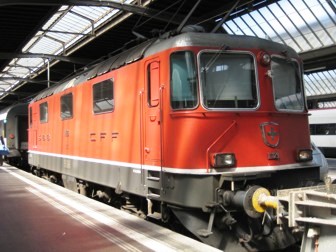
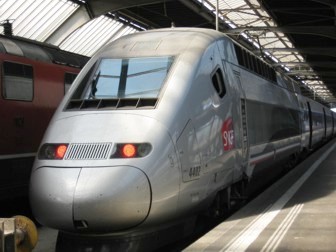
Zurich
HauptBahnhof - Modern Electrics
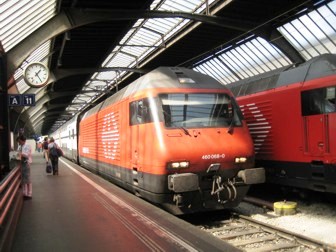
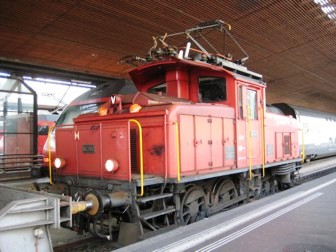
Zurich
HauptBahnhof - Modern Electrics and a Diesel Shunter
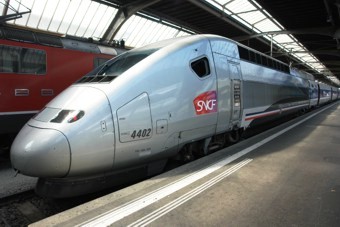 SNCF - fastest train in the world 574.8 km/hr {357 mph)
SNCF - fastest train in the world 574.8 km/hr {357 mph)
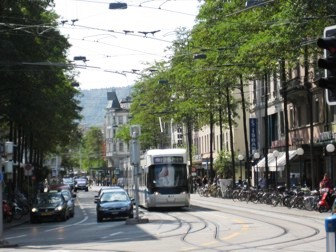
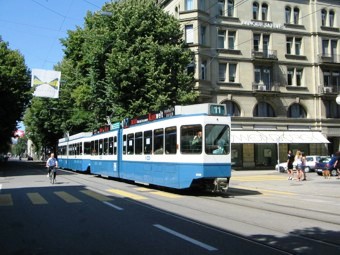
Zurich
BahnhofStrasse - Streetcars
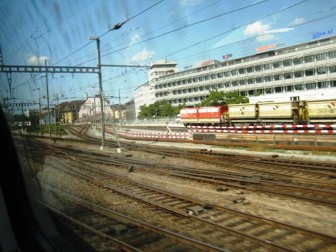
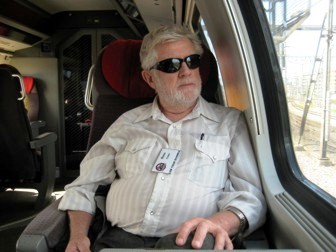
En Route to
Interlaken
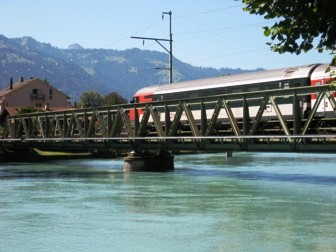
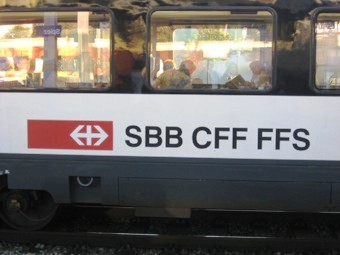
At Interlaken
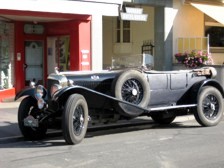
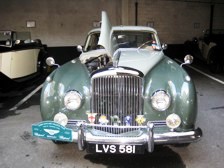
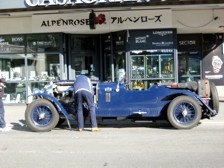
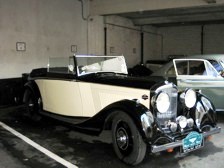

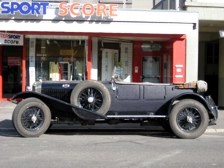
UK Bentley Car Club also stayed at Hotel Krebs, in transit
through Interlaken. Spectacular autos!
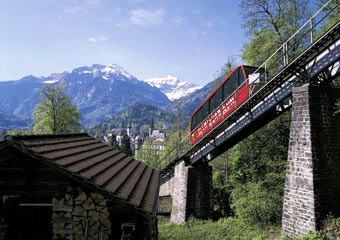
We rode the
funicular to the top of Harder Kulm for a picnic lunch and the
views across Interlaken and the Jungfrau. You can also
hike the route, up or down.
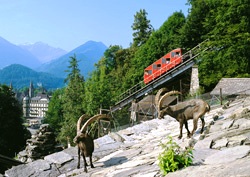
 SOME LOCAL TRAINS
SOME LOCAL TRAINS
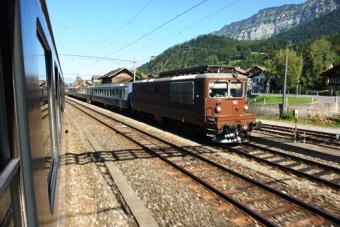
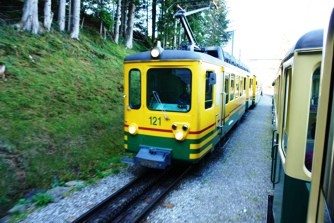
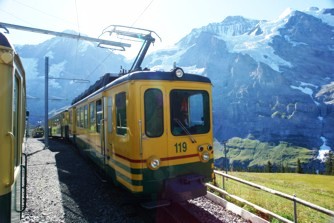
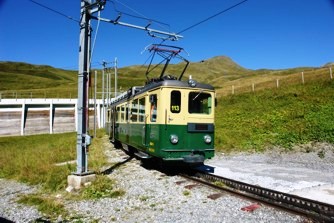
 INTERLAKEN to Montreux
and lake geneva
INTERLAKEN to Montreux
and lake geneva
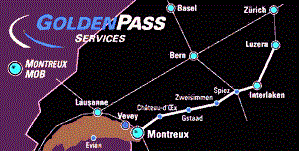 The
"Golden
Pass Line” counts as one of the spectacular railways
of Switzerland.
From
Interlaken, the Bern-Lötschberg-Simplon (BLS) runs on standard
gauge to Zweisimmen, where the line meets the Montreux-Berner
Oberland-Bahn (MOB), which brought us in modern panoramic cars
to Montreux
at Lake Geneva,
the Swiss Riviera. Montreux is in the French speaking region of
Switzerland and is the vacation home of numerous film and rock
stars. Because of the mild climate, unique Mediterranean scenery
has developed with palm trees and cypresses around the lake.
The
"Golden
Pass Line” counts as one of the spectacular railways
of Switzerland.
From
Interlaken, the Bern-Lötschberg-Simplon (BLS) runs on standard
gauge to Zweisimmen, where the line meets the Montreux-Berner
Oberland-Bahn (MOB), which brought us in modern panoramic cars
to Montreux
at Lake Geneva,
the Swiss Riviera. Montreux is in the French speaking region of
Switzerland and is the vacation home of numerous film and rock
stars. Because of the mild climate, unique Mediterranean scenery
has developed with palm trees and cypresses around the lake.
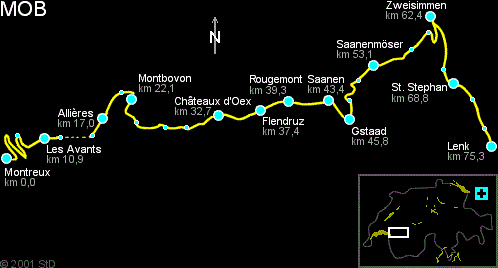
We changed trains
at
Zweisimmen because of the change in
gauge, but this is about to be overcome. By 2015, the panoramic
cars will have wheelsets that can change gauge and car height to
suit the portion of the road they are running on. Sounds
complicated but it is cheaper than rebuilding the rugged lines
and all the stations. A prototype car was under test in spring
of 2010.
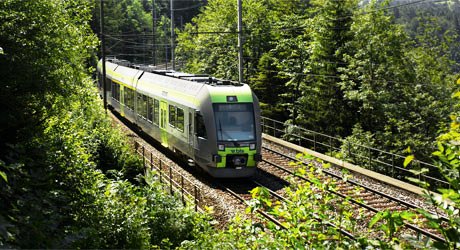
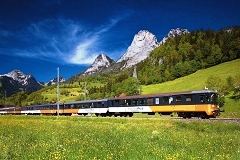
Bern-Lötschberg-Simplon (BLS) Railway scenes
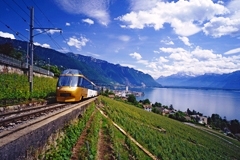
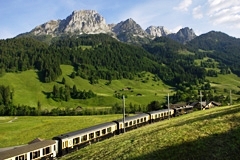
Montreux-Berner Oberland Bahn (MOB) scenes
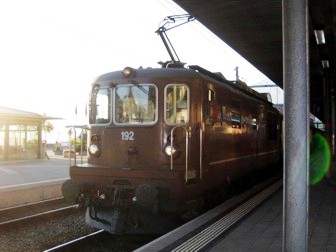
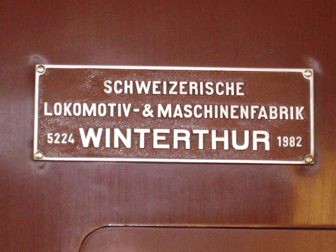
Leaving
Interlaken Ost
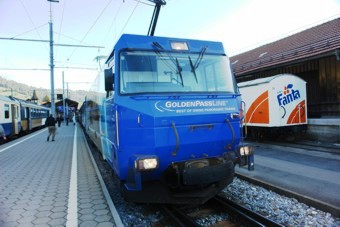
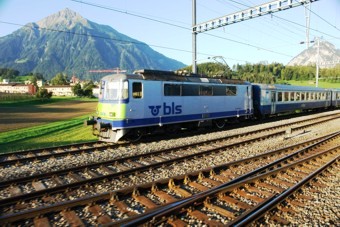
Golden Pass
locomotives
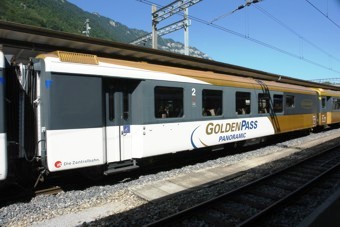
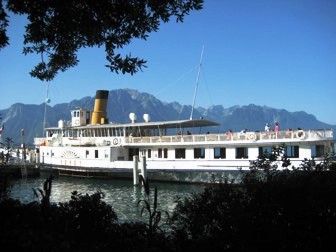
On the Golden
Pass and Lake Geneva cruise to the Chillon Castle
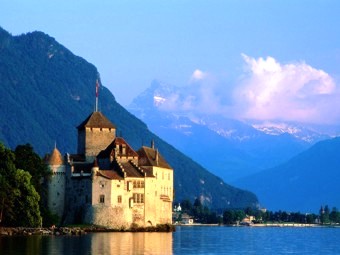
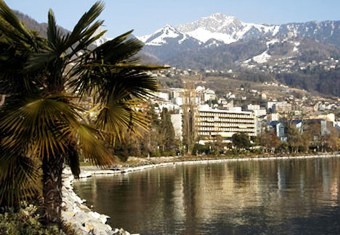
Chillon Castle
and Montreux on Lake Geneva
 SWITZERLAND REPRISE -- 2009
SWITZERLAND REPRISE -- 2009
Interlaken and Jungfrau Glacier
 This
section covers 5 small railways
near Interlaken including the Jungfrau Glacier- Top of Europe trip.
This
section covers 5 small railways
near Interlaken including the Jungfrau Glacier- Top of Europe trip.
 INTERLAKEN to
GRINDELWALD and
JUNGFRAU
INTERLAKEN to
GRINDELWALD and
JUNGFRAU
Using
three different railways in the right order, we can make a
"circle tour" of the Alps. The Berner Oberland Bahn
(BOB) meter gauge line connects Interlaken with the towns of
Grindelwald and Lauterbrunnen. The line opened in 1890 and was
electrified in 1914. Normally the trains going to Zweilütschinen
consist of two connected engines. Here, the engines are
disconnected and one train travels to Grindelwald while the
other train travels to Lauterbrunnen. Both towns offer train
connections to the Wengernalp Railway.
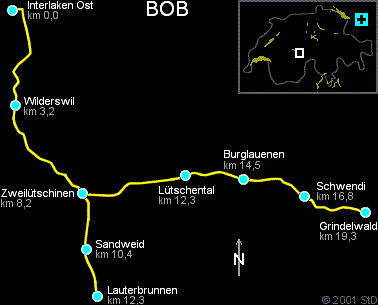
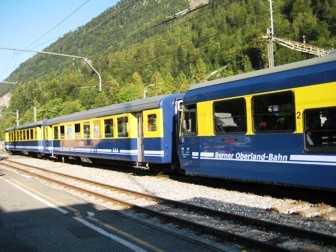
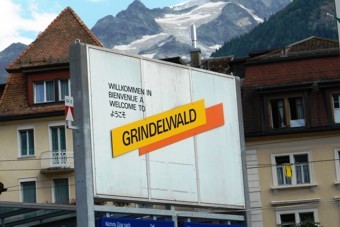
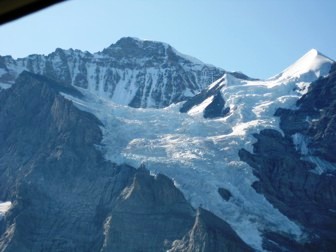
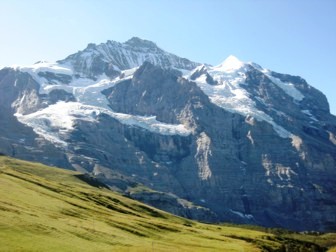
On the way to Jungfraujock
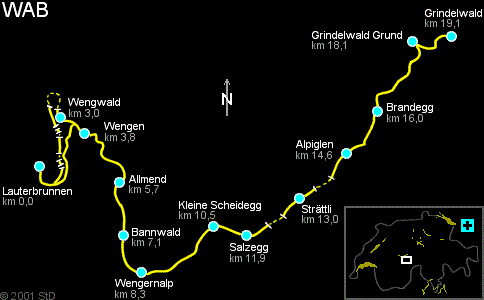 Wengernalp
Bahn (WAB), with 800 mm gauge track, is the world's longest
continuous rack railway, connecting Lauterbrunnen, Kleine
Scheidegg and Grindelwald, but the trains do not travel directly
from Lauterbrunnen over to Grindelwald. Kleine Scheidegg is the
starting point of the Jungfrau Railway.
Wengernalp
Bahn (WAB), with 800 mm gauge track, is the world's longest
continuous rack railway, connecting Lauterbrunnen, Kleine
Scheidegg and Grindelwald, but the trains do not travel directly
from Lauterbrunnen over to Grindelwald. Kleine Scheidegg is the
starting point of the Jungfrau Railway.
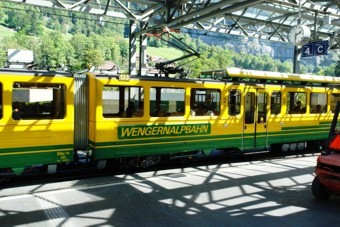
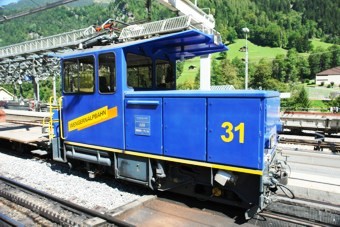
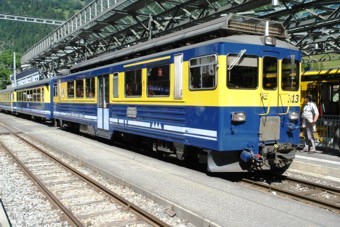
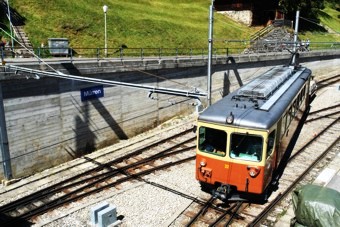
Wengernalp
Bahn lnterchange at Kleine
Scheidegg with the Jungfrau Bahn
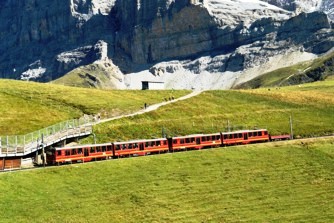
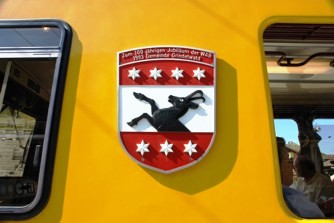
Wengernalp
Bahn lnterchange with BOB at Lauterbrunnen
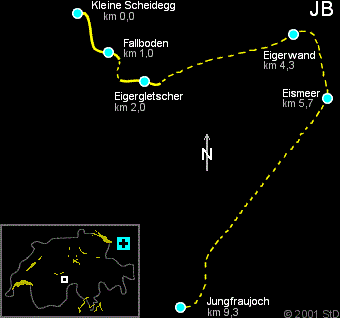 The
Jungfrau Bahn (JB) connects at Kleine Scheidegg station
with the Wengernalp Railway. The first track section from Kleine
Scheidegg to Eiger Glacier was opened in 1898. In 1903 the
section to the Eigerwand Station, and in 1905 the section to the
Eismeer Station was completed. Finally in 1912 the railway
reached the end destination at 3454 meters (11333 ft), just
below the summit of the Jungfraujoch (4158m / 13642 ft). The
majority of this line is in a tunnel and the Jungfrau station is
underground. At
the summit is a hotel, two restaurants, the Sphinx observatory
research station, and the glistening "Ice Palace" carved into
the living glacier. Called the "Top of Europe" the Jungfrau is
the highlight of any trip to Switzerland.
The
Jungfrau Bahn (JB) connects at Kleine Scheidegg station
with the Wengernalp Railway. The first track section from Kleine
Scheidegg to Eiger Glacier was opened in 1898. In 1903 the
section to the Eigerwand Station, and in 1905 the section to the
Eismeer Station was completed. Finally in 1912 the railway
reached the end destination at 3454 meters (11333 ft), just
below the summit of the Jungfraujoch (4158m / 13642 ft). The
majority of this line is in a tunnel and the Jungfrau station is
underground. At
the summit is a hotel, two restaurants, the Sphinx observatory
research station, and the glistening "Ice Palace" carved into
the living glacier. Called the "Top of Europe" the Jungfrau is
the highlight of any trip to Switzerland.

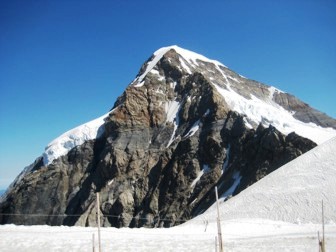
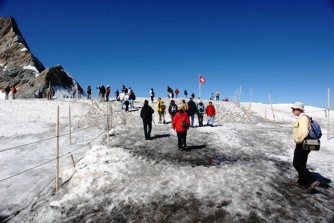
On the Jungfrau
Glacier
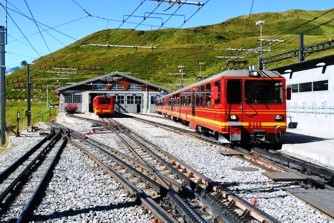
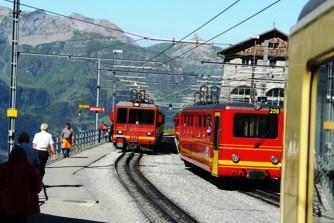
Kleine Scheidegg
station
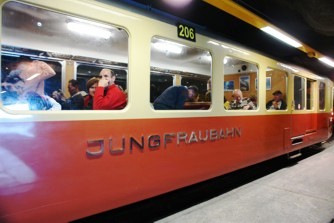
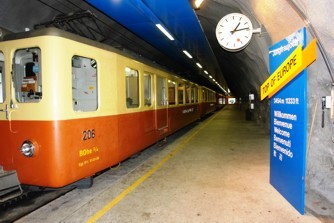
Jungfraujock station - Top of Europe 3454 meters
 INTERLAKEN to
LAKE
BRIENZ and LAKE THUN
INTERLAKEN to
LAKE
BRIENZ and LAKE THUN
Still steaming on 800 mm
track in 2009,
It took only a year
to build the Brienz Rothorn Bahn (BRB) in 1891. Regular service
continued until WWI forced an end to it in 1914. Then the line
stood still for 16 years. As a result, it became the last steam
operated cog railway, because all other cog lines had been
electrified. Even after 16 years, all the rolling stock was
still fully functional and operation started again in 1931. The
ride starts at the restored Valley Station just 15 Km from
Interlaken. Our locomotive, #12, was built in 1992.
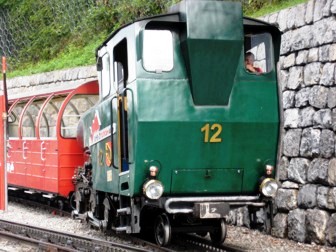
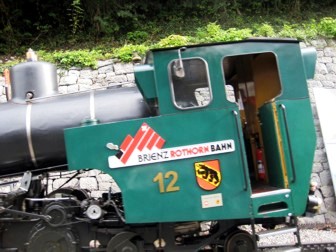
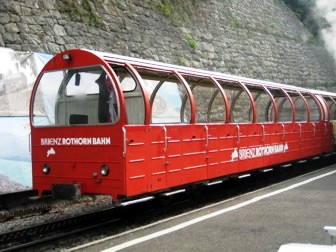
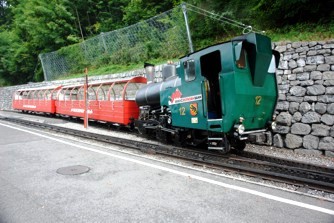
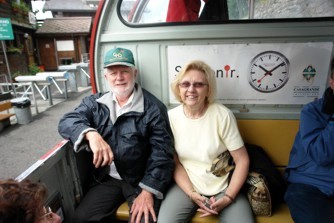
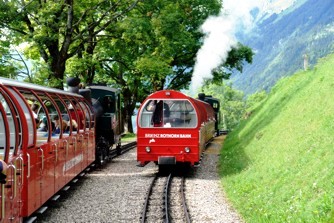
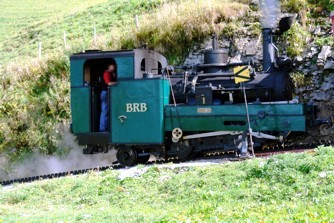
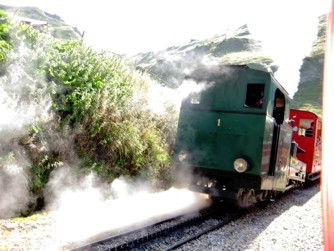
Old #1 (2nd) built 1892
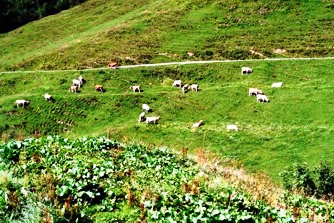
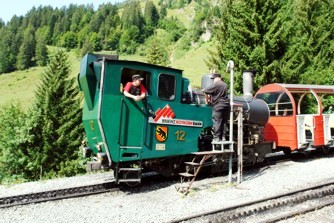
Swiss chocolate on the hoof
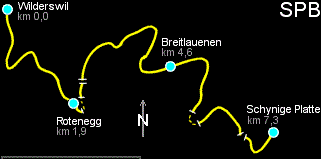 The
Schynige Platte Bahn (SPB) was opened in 1893 and
electrified in 1914. Many of its carriages and locomotives were
first in service on the Wengernalp Railway. The 800 mm gauge cog
railway starts in Wilderswill, near Interlaken, and climbs
1420 meters over a distance of 7.25 km. Fog and rain obscured views of
the Lakes Thun and Brienz, and
the peaks of Eiger, Monch, and Jungfrau. The alpine garden is a
highlight at the summit station.
The
Schynige Platte Bahn (SPB) was opened in 1893 and
electrified in 1914. Many of its carriages and locomotives were
first in service on the Wengernalp Railway. The 800 mm gauge cog
railway starts in Wilderswill, near Interlaken, and climbs
1420 meters over a distance of 7.25 km. Fog and rain obscured views of
the Lakes Thun and Brienz, and
the peaks of Eiger, Monch, and Jungfrau. The alpine garden is a
highlight at the summit station.
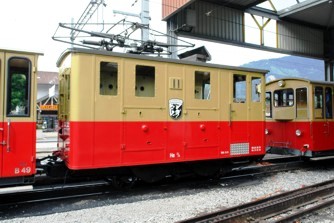
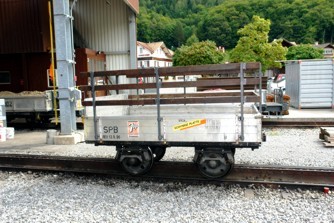
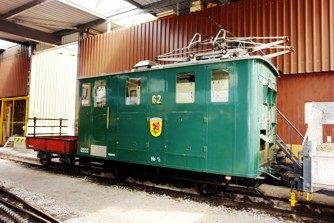
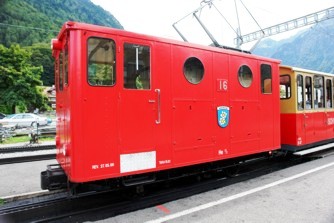
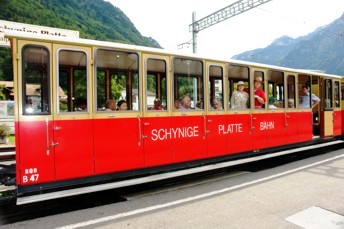
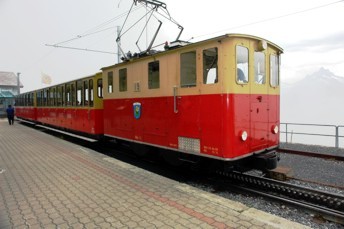
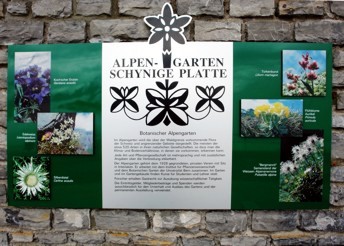
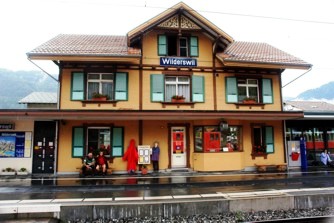
 SWITZERLAND REPRISE -- 2009
SWITZERLAND REPRISE -- 2009
Interlaken - Visp - Zermatt - Gornergrat
And Mount Pilatus - Lake Lucerne
 This
section covers a trip taken
from our hub at Interlaken to reach the Glacier Express at Visp,
then on to Zermatt, up the Gornergrat Bahn to the base of
the Matterhorn and return to Interlaken. Next day we traveled to
Mt Pilatus and Lake Lucerne.
This
section covers a trip taken
from our hub at Interlaken to reach the Glacier Express at Visp,
then on to Zermatt, up the Gornergrat Bahn to the base of
the Matterhorn and return to Interlaken. Next day we traveled to
Mt Pilatus and Lake Lucerne.
 INTERLAKEN to
ZERMATT
INTERLAKEN to
ZERMATT
We cruised through the Gotthard Tunnel to Visp on a sleek
high-speed ICE, where we reached the route
of the Glacier Express, then headed for Zermatt and the Matterhorn
on the Matterhorn-Gotthard-Bahn (MGB)
(meter gauge). It was created in 2003 through an amalgamation
of Furka-Oberalp-Bahn (FO) and Brig-Visp-Zermatt Bahn (BVZ). The
name comes from the Matterhorn and St. Gotthard Pass. Its
network is 144 km (89.5 mi) long and stretches from Disentis to
Zermatt, by way of the Oberalp pass and Andermatt, the Furka
tunnel, Brig, and Visp. From Andermatt, a branch line (the
former independent Schöllenenbahn) extends to Göschenen, at the
northern end of the Gotthard rail tunnel.
Between Realp and Oberwald, the
line formerly crossed the Furka pass, at a crest elevation of
2162 meters (7093 ft) with a 1.87 km (1.16 mi) tunnel passing beneath
the peak. Today, a new tunnel crests at just 1564 m (5131 ft)
and is 15.34 km (9.53 mi) long. I was on the old line in 1995
and it was far more interesting than the present one.
The old line is operated by the
Dampfbahn Furka-Bergstrecke (DFB) using veteran steam engines.
There is a connection to the Rhaetian Railway in Disentis and
the Glacier Express runs from Zermatt to St. Moritz, using stock
from both companies. Unfortunately, there was no time to get to
this scenic trackage.
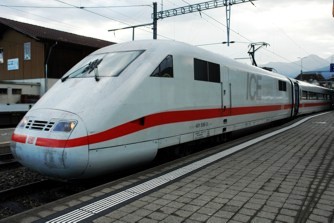
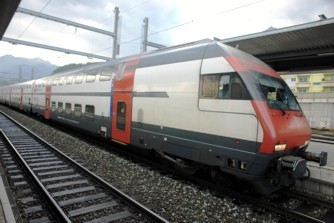
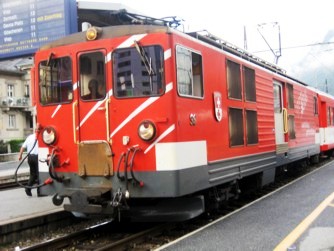
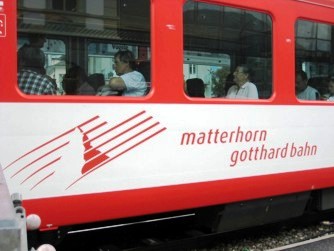
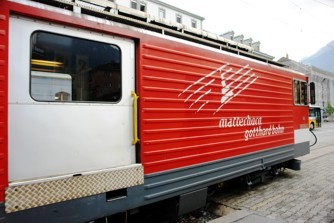
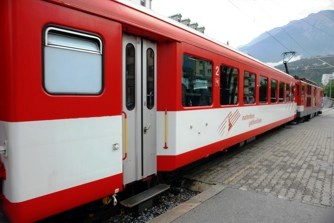
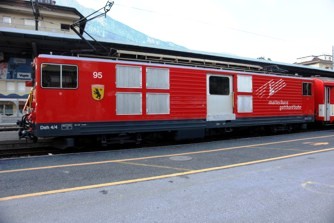
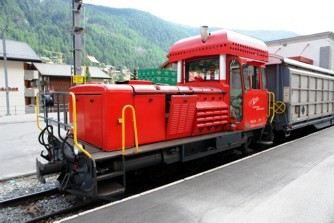
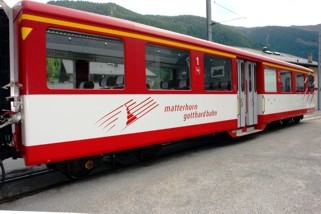
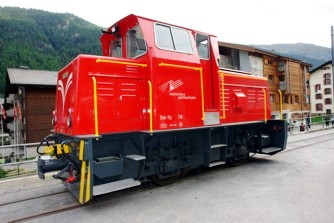
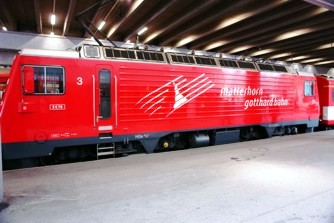
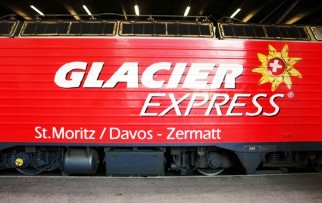
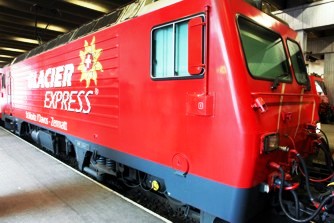
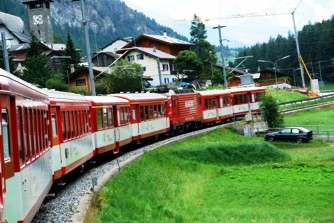
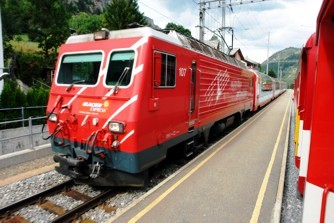
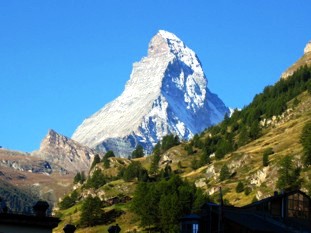
 ZERMATT
TO GORNERGRAT
ZERMATT
TO GORNERGRAT
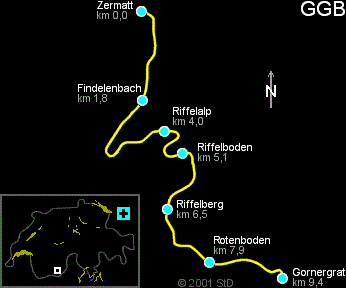 From
Zermatt, we headed uphill on the meter gauge Gornergrat Bahn (GGB)
cogwheel route. The construction commenced in 1896. A total
of 2400 workers were employed over a 2-year period. In 1898, the
train on Switzerland's first electrical cog railway made its way
towards the Matterhorn. 100 years ago, in 1909, the
summit station was re-sited around 70 meters further up the
mountain. This in turn made the Gornergrat Bahn Europe's highest
open-air cogwheel railway. The Jungfrau is higher but in a
tunnel.
From
Zermatt, we headed uphill on the meter gauge Gornergrat Bahn (GGB)
cogwheel route. The construction commenced in 1896. A total
of 2400 workers were employed over a 2-year period. In 1898, the
train on Switzerland's first electrical cog railway made its way
towards the Matterhorn. 100 years ago, in 1909, the
summit station was re-sited around 70 meters further up the
mountain. This in turn made the Gornergrat Bahn Europe's highest
open-air cogwheel railway. The Jungfrau is higher but in a
tunnel.
 I
I
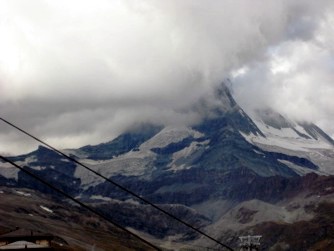
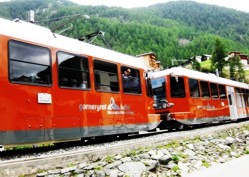
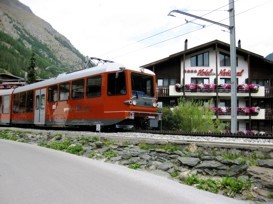
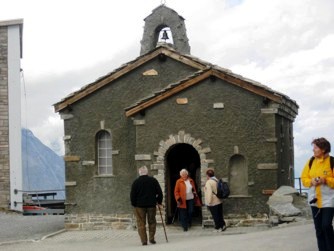
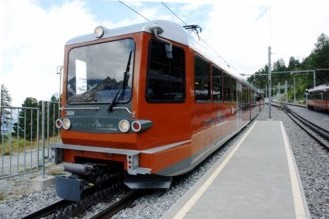
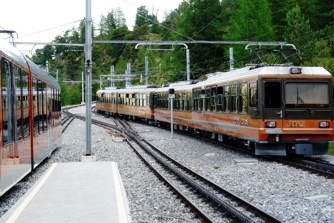

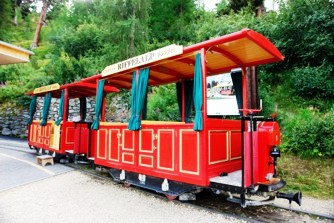
Gornergratbahn to
the Matterhorn
 INTERLAKEN to
PILATUS and LAKE LUCERNE
INTERLAKEN to
PILATUS and LAKE LUCERNE
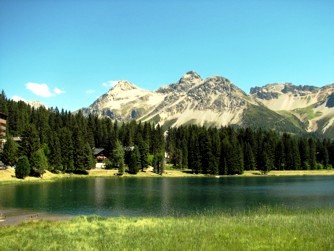 After a cruise on Lake Lucerne we
climbed up to the summit of Mount Pilatus on board the steepest
cog railway in the world, the Pilatus Bahn.
First
built in 1889, it changed to electrical operation in 1937.
We then descended on the aerial
cableway -- the last trip of the day for the gondola due to gusty
winds -- a very exciting ride. After a brief bus ride and a walk
around downtown Lucerne, we traveled back to Interlaken on
another
ICE.
After a cruise on Lake Lucerne we
climbed up to the summit of Mount Pilatus on board the steepest
cog railway in the world, the Pilatus Bahn.
First
built in 1889, it changed to electrical operation in 1937.
We then descended on the aerial
cableway -- the last trip of the day for the gondola due to gusty
winds -- a very exciting ride. After a brief bus ride and a walk
around downtown Lucerne, we traveled back to Interlaken on
another
ICE.
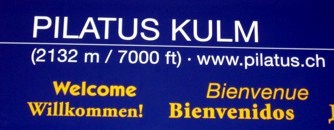
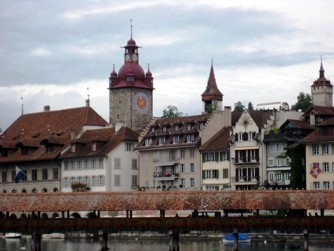
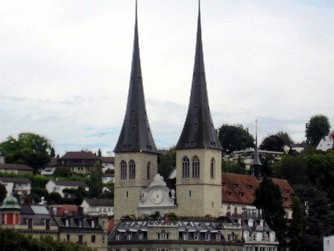
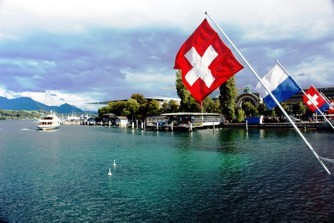
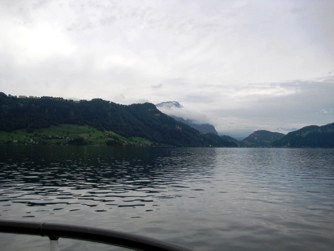
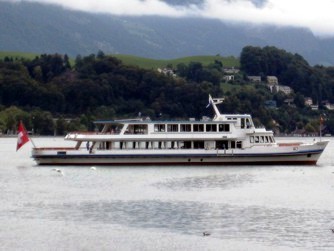
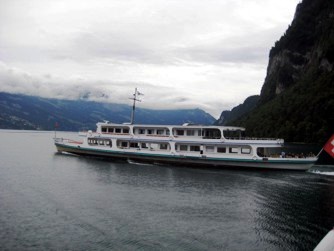
Lucerne and the
Lake
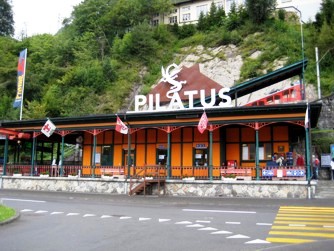
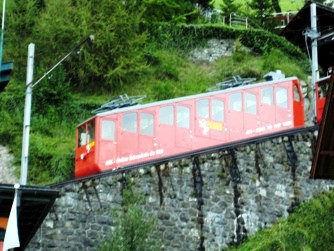
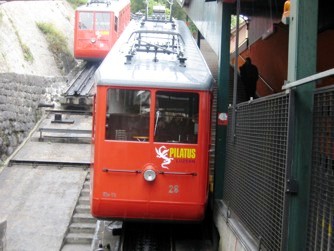
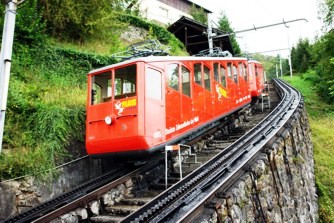
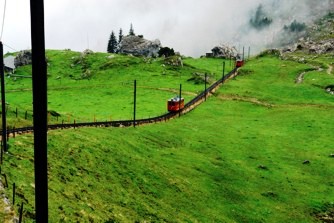
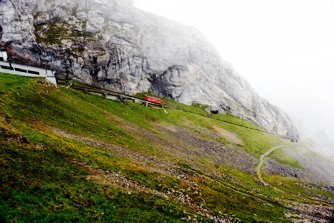
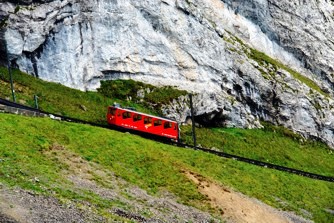
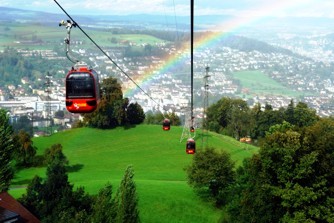
Mt Pilatus - Straight up on the cog and straight down on the
cable.
 SWITZERLAND
REPRISE -- 2009
SWITZERLAND
REPRISE -- 2009
Interlaken
- Zurich - Chur - Tirano - Chur - Arosa - Zurich
 After
the tour, we headed theough Zurich to Chur tocatch the Bernina
Express to Tirano in Italy. On the return to Chur, we took a
sidetrip to Arosa, then back to Zurich for the plane home.
All this was covered in a leisurely 4 day self guided
excursion.
After
the tour, we headed theough Zurich to Chur tocatch the Bernina
Express to Tirano in Italy. On the return to Chur, we took a
sidetrip to Arosa, then back to Zurich for the plane home.
All this was covered in a leisurely 4 day self guided
excursion.
The tour itself was extremely well managed by John Rogers and
his wife at LGB Tours. Their constant guidance each day was
very courteous and helpful. They also arranged all the details
of our self-guided extension, which made the finale to our trip
completely trouble free.
 INTERLAKEN
TO CHUR VIA ZURICH
INTERLAKEN
TO CHUR VIA ZURICH
We left Interlaken on the ICE via Bern to
Zurich , said good bye to the tour group and continued on to
Chur. It was a Saturday and the trains were nearly empty - we
essentially had a private car for the Zurich to Chur leg of the
journey. Chur is the oldest city in Switzerland, dating back at
least 1000 years. We stayed at the Post Hotel (now managed by
Comfort Inns), much modernized since my previous stay 14 years
earlier. The railway station was also new and just a short walk
from the hotel.
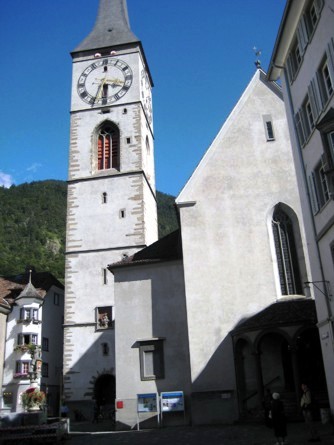
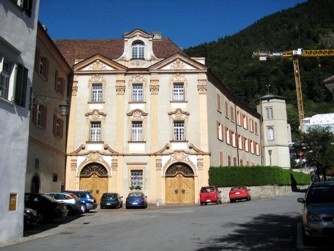
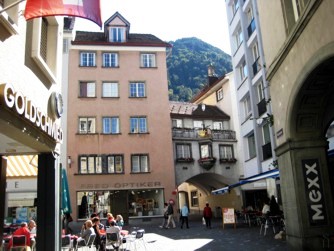
 CHUR
TO TIRANO - BERNINA EXPRESS
CHUR
TO TIRANO - BERNINA EXPRESS
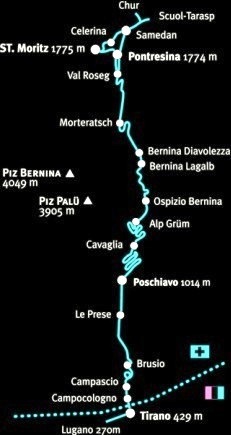 The
Bernina Express is still the best train ride in Switzerland and
a UNESCO World Heritage Site. Glaciers, lakes, spiral tunnels
and viaducts, all leading to semi-tropical vineyards in Italy.
Tirano (not to be confused with Torino farther south) is a
border town, probably as ancient as Chur, and is the connection
point to the Italian State Railway.
The
Bernina Express is still the best train ride in Switzerland and
a UNESCO World Heritage Site. Glaciers, lakes, spiral tunnels
and viaducts, all leading to semi-tropical vineyards in Italy.
Tirano (not to be confused with Torino farther south) is a
border town, probably as ancient as Chur, and is the connection
point to the Italian State Railway.
Grades of up to 7% are handled without rack and pinion traction,
and the line handles considerable freight as well as the better
known tourist traffic.
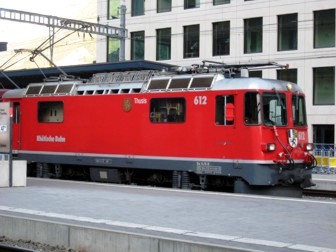
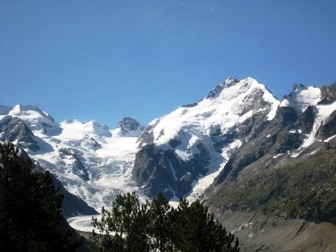
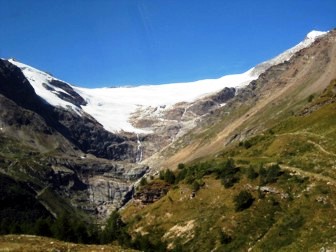
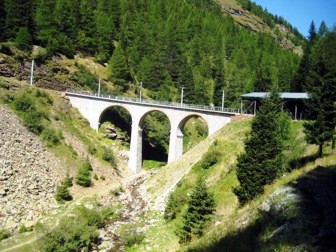
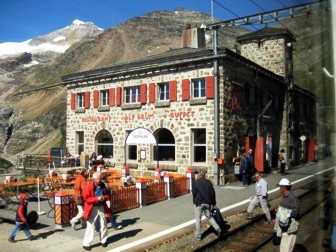
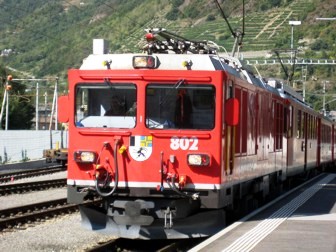
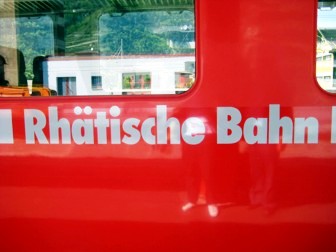
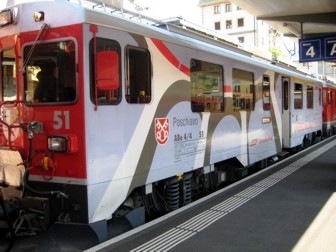
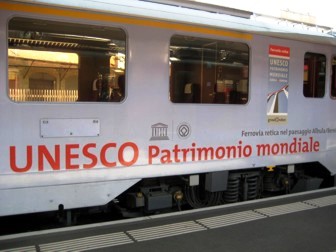
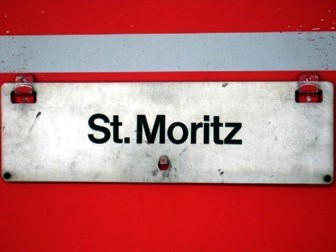
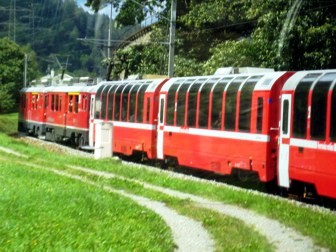
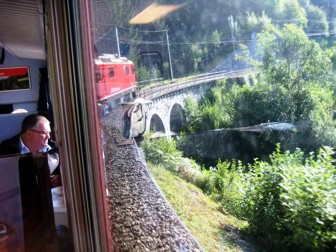
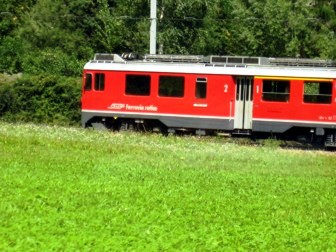
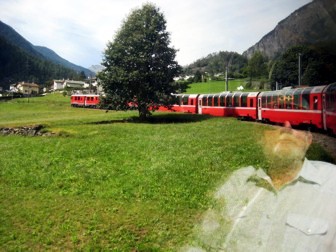
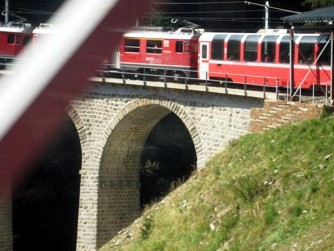
The Bernina is easy to see
from inside the panorama cars.
 TIRANO
SCENES
TIRANO
SCENES
The Bernina arrives at noon
and leaves again at 1 PM, so we stayed overnight at Hotel
Bernina to give us time to explore the old city and cathedrals.
Compared to the gleam and polish of the Swiss counterparts, the
Italian trains looked beaten-up and grubby.
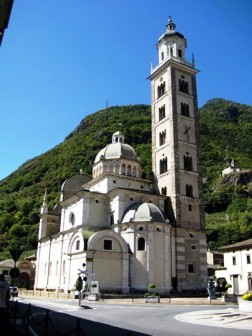
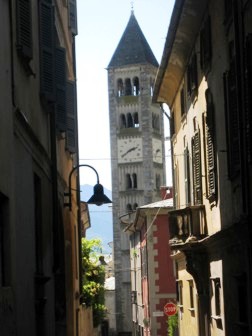
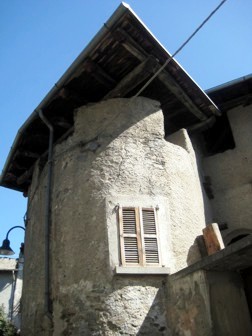
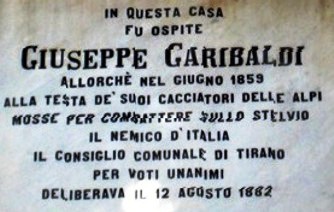
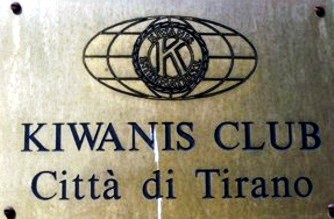
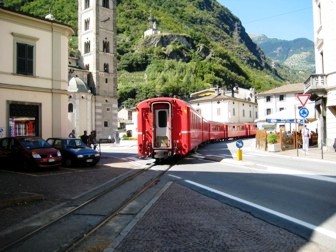
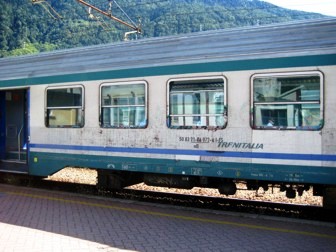
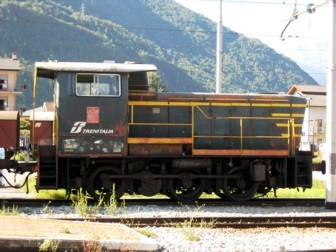
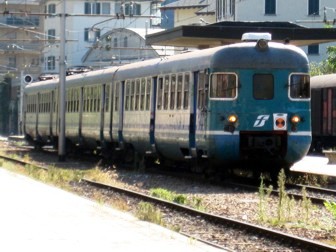
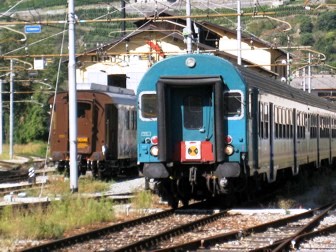
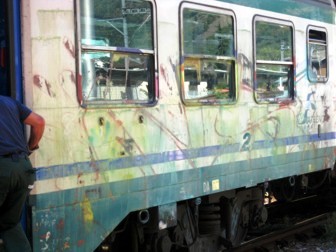
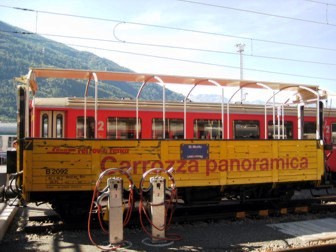
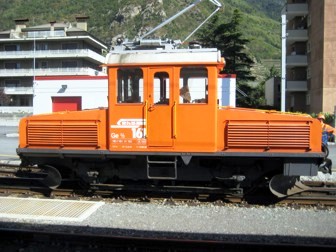
The Italian trains are not as
pretty as the Swiss.
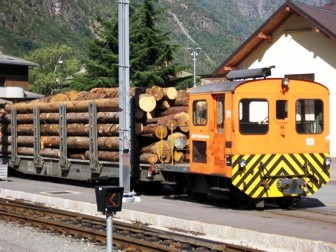
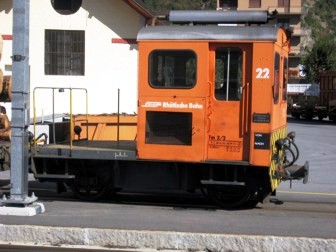
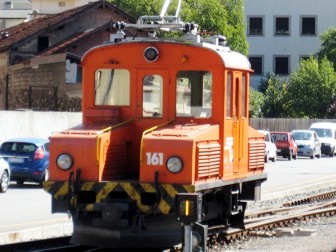
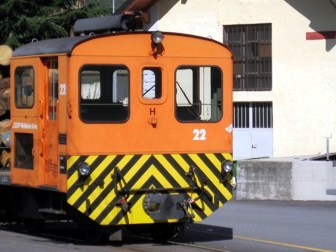
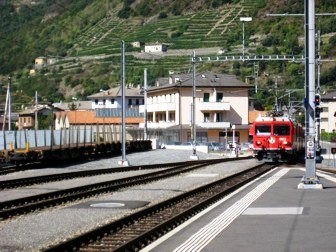
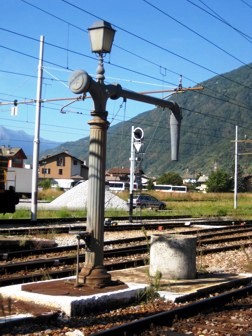
Work trains and log
buggies mingle with the Bernina at Tirano Station.
 CHUR
TO AROSA
CHUR
TO AROSA
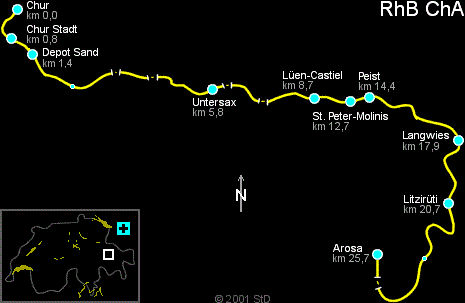 This
is a beautiful trip to a beautiful lakeside town - if they would
have me, this would be my retirement home. The
Chur-Arosa railway was founded in 1889 as an independent company
(ChA) and its network had always been linked to the main network
of the RhB in Chur. This link enables the exchange of passenger
coaches and freight cars. The merger with the RhB was the
beginning of the modernization of the ChA railway.
This
is a beautiful trip to a beautiful lakeside town - if they would
have me, this would be my retirement home. The
Chur-Arosa railway was founded in 1889 as an independent company
(ChA) and its network had always been linked to the main network
of the RhB in Chur. This link enables the exchange of passenger
coaches and freight cars. The merger with the RhB was the
beginning of the modernization of the ChA railway.
Leaving Chur, the route follows the streets of the upper part of
town to gain access to the Plessur River valley. There are 41
bridges and 21 tunnels on the 25 Km of the meter gauge
line.
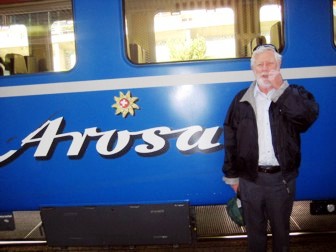
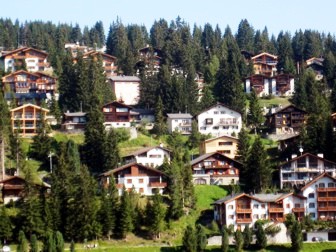
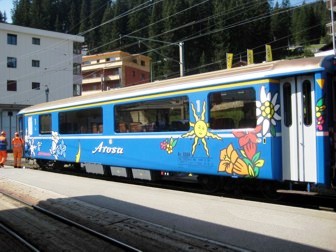
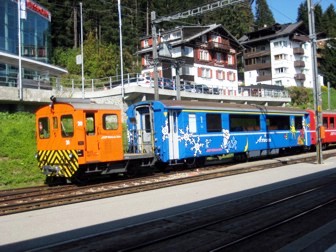
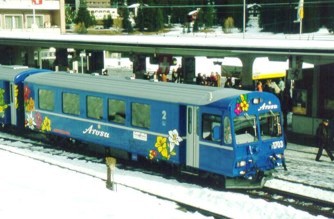
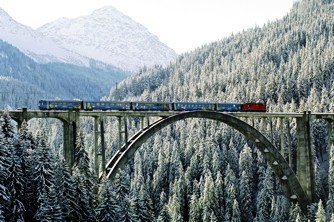

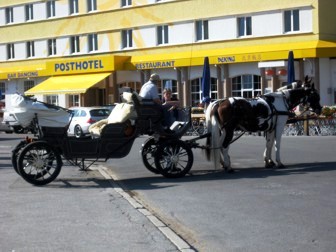
Slow and easy is the the only way to move in Arosa


 The
route started with Calgary to Frankfurt by Lufthansa/Air Canada,
then by train to Nurnberg where I joined the tour group from the
USA. After a sumptuous meal and an overnight in an ancient hotel,
we toured the LGB model train factory. There is a very impressive
display railway built by Malcolm Furlow. The factory is huge and
full of fascinating machinery.
The
route started with Calgary to Frankfurt by Lufthansa/Air Canada,
then by train to Nurnberg where I joined the tour group from the
USA. After a sumptuous meal and an overnight in an ancient hotel,
we toured the LGB model train factory. There is a very impressive
display railway built by Malcolm Furlow. The factory is huge and
full of fascinating machinery.


















 We
stayed in Munich a couple of days to see the old city, take part
in pre-Octoberfest, and visit the Munich Science Museum. Many
fabulous antiques, from trains to automobiles to airplanes to
ships, are on display, along with many large scale working models.
There is much more to see: art galleries, the old walled city
(now shops, boutiques, and restaurants), ancient and modern streetcars
on the U-Bahn, and the modern trains on the S-Bahn.
We
stayed in Munich a couple of days to see the old city, take part
in pre-Octoberfest, and visit the Munich Science Museum. Many
fabulous antiques, from trains to automobiles to airplanes to
ships, are on display, along with many large scale working models.
There is much more to see: art galleries, the old walled city
(now shops, boutiques, and restaurants), ancient and modern streetcars
on the U-Bahn, and the modern trains on the S-Bahn.















 The
Austrian segment of the trip took us to Saltzburg, St Wolfgang,
Berchtesgaden, Jenbach, Achensee, Innsbruck, and Feldkirk where
we entered Switzerland through Liechtenstein, one of the smallest
countries in the world.
The
Austrian segment of the trip took us to Saltzburg, St Wolfgang,
Berchtesgaden, Jenbach, Achensee, Innsbruck, and Feldkirk where
we entered Switzerland through Liechtenstein, one of the smallest
countries in the world. The mainline through
trains in Austria are standard gauge run by OBB. There are large
meter gauge installations like the Zillertahlbann and many small
restored tourist lines.
The mainline through
trains in Austria are standard gauge run by OBB. There are large
meter gauge installations like the Zillertahlbann and many small
restored tourist lines. 























 Next
day, we returned to Jenbach to board the Achenseebahn, another
narrow gauge rack railway with steam locomotives. The Achenseebahn
terminates at the lake, where a steam paddle-wheel ferry can be
taken to the other shore. This is a big lake with imposing mountain
peaks and glaciers. The town is small, very neat, and offers a
decent lunch.
Next
day, we returned to Jenbach to board the Achenseebahn, another
narrow gauge rack railway with steam locomotives. The Achenseebahn
terminates at the lake, where a steam paddle-wheel ferry can be
taken to the other shore. This is a big lake with imposing mountain
peaks and glaciers. The town is small, very neat, and offers a
decent lunch.







 It was either too dark or too rainy to take pictures in
Innsbruck, so I grabbed these to give you an idea of what
we missed.
It was either too dark or too rainy to take pictures in
Innsbruck, so I grabbed these to give you an idea of what
we missed. Here,
we rode
on a lot of trains and saw a lot of scenery. The Swiss National
Railway (SBB) is standard gauge (1435 mm).
Here,
we rode
on a lot of trains and saw a lot of scenery. The Swiss National
Railway (SBB) is standard gauge (1435 mm).








 Next
stop was Chur, the headquarters for the Ratischebahn (RhB), and
our tour group for a few days. The city is the most ancient in
Switzerland, dating back at least 5000 years. Some of the cathedrals
are more than 500 years old. The library has documents written
by Irish scholar-monks dating back more than 1000 years!
Next
stop was Chur, the headquarters for the Ratischebahn (RhB), and
our tour group for a few days. The city is the most ancient in
Switzerland, dating back at least 5000 years. Some of the cathedrals
are more than 500 years old. The library has documents written
by Irish scholar-monks dating back more than 1000 years!











 We
rode the Chur to Zermatt route in a first class observation car.
The "box-lunch" comes in a box all right, but contains
enough food and wine for several days. Scenery along the Rhine
is interesting and cannot be seen by car or bus. Once onto the
rack lines of the Alps, the scenery is a combination of spectacular
to barren. The Bernina route is prettier.
We
rode the Chur to Zermatt route in a first class observation car.
The "box-lunch" comes in a box all right, but contains
enough food and wine for several days. Scenery along the Rhine
is interesting and cannot be seen by car or bus. Once onto the
rack lines of the Alps, the scenery is a combination of spectacular
to barren. The Bernina route is prettier. 































 This
trip was run by LGB Tours and guided by the
owners, John Rogers and his family. Centered around Interlaken, jt covered a lot of new ground for me, but I extended the tour
for a week to repeat the Bernina and Arosa trips I had taken in
1995, at a more leisurely pace. Sonja took more than 600 photos
and the tour guide provided another 1200; a few of them are shown
on this page to serve as memory-aids to a fabulous trip.
This
trip was run by LGB Tours and guided by the
owners, John Rogers and his family. Centered around Interlaken, jt covered a lot of new ground for me, but I extended the tour
for a week to repeat the Bernina and Arosa trips I had taken in
1995, at a more leisurely pace. Sonja took more than 600 photos
and the tour guide provided another 1200; a few of them are shown
on this page to serve as memory-aids to a fabulous trip.














 The
Schynige Platte Bahn (SPB) was opened in 1893 and
electrified in 1914. Many of its carriages and locomotives were
first in service on the Wengernalp Railway. The 800 mm gauge cog
railway starts in Wilderswill, near Interlaken, and climbs
1420 meters over a distance of 7.25 km. Fog and rain obscured views of
the Lakes Thun and Brienz, and
the peaks of Eiger, Monch, and Jungfrau. The alpine garden is a
highlight at the summit station.
The
Schynige Platte Bahn (SPB) was opened in 1893 and
electrified in 1914. Many of its carriages and locomotives were
first in service on the Wengernalp Railway. The 800 mm gauge cog
railway starts in Wilderswill, near Interlaken, and climbs
1420 meters over a distance of 7.25 km. Fog and rain obscured views of
the Lakes Thun and Brienz, and
the peaks of Eiger, Monch, and Jungfrau. The alpine garden is a
highlight at the summit station.  From
Zermatt, we headed uphill on the meter gauge Gornergrat Bahn (GGB)
cogwheel route. The construction commenced in 1896. A total
of 2400 workers were employed over a 2-year period. In 1898, the
train on Switzerland's first electrical cog railway made its way
towards the Matterhorn. 100 years ago, in 1909, the
summit station was re-sited around 70 meters further up the
mountain. This in turn made the Gornergrat Bahn Europe's highest
open-air cogwheel railway. The Jungfrau is higher but in a
tunnel.
From
Zermatt, we headed uphill on the meter gauge Gornergrat Bahn (GGB)
cogwheel route. The construction commenced in 1896. A total
of 2400 workers were employed over a 2-year period. In 1898, the
train on Switzerland's first electrical cog railway made its way
towards the Matterhorn. 100 years ago, in 1909, the
summit station was re-sited around 70 meters further up the
mountain. This in turn made the Gornergrat Bahn Europe's highest
open-air cogwheel railway. The Jungfrau is higher but in a
tunnel. 
 The
Bernina Express is still the best train ride in Switzerland and
a UNESCO World Heritage Site. Glaciers, lakes, spiral tunnels
and viaducts, all leading to semi-tropical vineyards in Italy.
Tirano (not to be confused with Torino farther south) is a
border town, probably as ancient as Chur, and is the connection
point to the Italian State Railway.
The
Bernina Express is still the best train ride in Switzerland and
a UNESCO World Heritage Site. Glaciers, lakes, spiral tunnels
and viaducts, all leading to semi-tropical vineyards in Italy.
Tirano (not to be confused with Torino farther south) is a
border town, probably as ancient as Chur, and is the connection
point to the Italian State Railway.  This
is a beautiful trip to a beautiful lakeside town - if they would
have me, this would be my retirement home.
This
is a beautiful trip to a beautiful lakeside town - if they would
have me, this would be my retirement home. 
